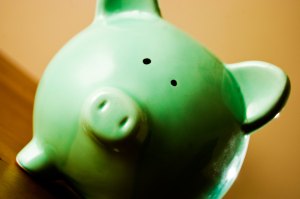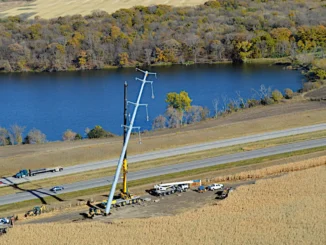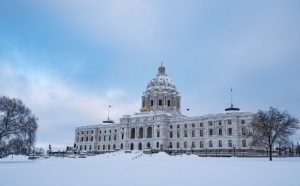
A proposal to establish Minnesota’s first “green bank” would make it easier and less expensive to finance climate and clean energy projects in the state, supporters say.
The Minnesota Climate Innovation Finance Authority would receive $45 million in one-time state money to create a self-sustaining lending institution that would be able to offer businesses and homeowners longer terms and lower interest rates than are currently available for projects such as weatherization, solar panels and heat pumps.
The finance authority would also provide a backstop to traditional lenders, guaranteeing loan repayments for qualifying projects in hopes of freeing up more private money for green financing, especially in low-income communities where access to capital is a bigger barrier.
Similar programs have already been established in more than 20 states, according to the Coalition for Green Capital. The idea has come up in past legislative sessions in Minnesota, but advocates are optimistic about its chances this session thanks to the state budget surplus and Democrats’ majorities in both chambers. Gov. Tim Walz has expressed support for the concept.
Some financing options already exist, such as loan programs administered by the Center for Energy and Environment, but gaps exist especially for low- and moderate-income households who may not qualify for conventional loans or community solar programs because of poor credit scores or lack of collateral.
Democratic legislators also believe a green bank will be needed to take full advantage of federal money from the Inflation Reduction Act.
Sign up for Energy News Weekly
Get the most important energy news of the week delivered directly to your inbox.
Supporters of the current legislation in Minnesota say they want to be careful not to compete with existing lenders. The proposal includes money for a study to determine what clean energy lending areas are underserved so the authority does not duplicate or replace existing financing sources.
Sen. Tou Xiong, a Democrat from Maplewood who authored the Senate bill, said lenders “are doing great work, but there are [financing] gaps and the speed at which we want to make that transition into clean energy has a long way to go.”
He said that the finance authority would help the state capitalize on funding opportunities in the federal Inflation Reduction Act and also help bolster financing for weatherization and other programs the state struggles to fund. The green bank would lend to nonprofits, businesses and individuals.
Interfaith Power & Light has been instrumental in forging a coalition of supporters for the legislation that includes the Sierra Club, MN 350, and the Minnesota Center for Environmental Advocacy. The group’s strategic policy director, Sarah Wolff, said the financial authority would provide lending as well as technical assistance.
“It will create a central place where information on what’s possible will be available and assistance with coordination,” Wolff said.
Sarah Mooradian, government relations and policy director for Clean Up the River Environment, said the authority would help rural communities where clean energy developers and farmers often struggle with financing.
“I think that’s going to be critical for small communities, individuals and smaller organizations in rural communities who just don’t have the manpower, or the staff or the expertise to fill out these complex applications,” Mooradian said.
One type of project she thinks could be financed by the green bank would be resiliency hubs with solar and battery storage at libraries or community centers. “Making sure the community is involved with and takes ownership of and gets the benefits of these projects is important,” she said.
The finance authority could help daycare providers add solar to lower or stabilize childcare costs and assist people in older homes in paying for better insulation, Mooradian said.
Supporters say an additional lending option will be a key toward achieving Minnesota’s recent law calling for carbon-free electricity by 2040. Co-author Rep. Emma Goodman, a Democrat from Minneapolis, said states with green banks, such as Connecticut, Colorado and Michigan, have increased the speed and scale of clean energy investment. When discussing the House bill, she said her committee heard from solar developers struggling to find bank financing for projects in low-income communities.
Traditional lenders want a quicker return and greater security than some developers can offer, especially those working with underserved customers. Once created, the finance authority will leverage its initial investment into hundreds of millions of federal dollars, Goodman said.
Minneapolis attorney Jeremy Kalin introduced the first green bank bill as a lawmaker more than a decade ago and assisted in crafting the current legislation. He said the primary goal is to encourage greater lending by private capital on projects that might otherwise find no loans available, even from public entities.
For example, Kalin suggested the finance authority could help farmers finance buffer strips next to streams and rivers that could reduce the need for upstream wastewater plants “for pennies on the dollar.” The loans to farmers could be paid for by cities upstream looking to avoid significant infrastructure investments.
The finance authority could help developers place more energy efficiency in multifamily housing. Kalin said developers face many restrictions on mortgage loans that make adding more efficiency measures to housing more difficult. But he said a secured or unsecured loan from the finance authority could yield utility rebates that pay for a significant share, sometimes over half, of the cost of improvements.
After a pilot becomes viable with assistance from the finance authority, other private lenders and public entities can step forward to scale the project much larger.
“Once you have some data and show that [a project] can work, then it’s pretty easy to think about bringing in any number of community banks, financial institutions, nonprofit lenders, or even foundation money that could serve as that loan capital,” Kalin said.
One clean energy developer who likes the prospect of a green bank is Amber Naqvi, CEO of Lake Street Solar. His company installs solar in low-income neighborhood institutions such as community centers, nonprofits and churches. Lake Street Solar’s clients have no upfront costs for solar installations and pay less for the electricity produced by the panels than they would for power from Xcel Energy.
After maintaining the projects for years and taking advantage of tax incentives, the company will sell them to clients at steep discounts. Naqvi said he invested $1 million of his own money on several projects and would like to do more, but banks have little interest in offering smaller loans.
A $1 million loan is too little and requires too much paperwork for lenders or corporations looking for “environmental, social and corporate governance” (ESG) partners. “They say, ‘for us to do $1 million or $2 million in a community just isn’t going to work,’” Naqvi said.
Most small clients do not have the initial capital to invest in solar, leaving them without any way to take advantage of federal tax credits. He said a finance authority would “grease the wheels” to allow Lake Street Solar to get smaller loans and double or triple the number of projects completed annually in low-income neighborhoods.
Lake Street Solar works closely with Interfaith Power & Light on recruiting new clients. This year the company will complete around five projects and has several more in the pipeline that could finish more quickly with additional financing, Naqvi said.
One of its projects, the Lundstrum Performing Arts, received recognition from the Environmental Initiative for local sustainability. “People want clean energy, they want less reliance on fossil fuel, they also want to stop the [energy] rate increases that are happening,” Naqvi said.
One of the state’s largest green lenders is the Center for Energy and Environment, which last year did $24.9 million worth of loans. Chris Duffrin, the nonprofit’s president, said that the combination of Inflation Reduction Act money and a green bank could help lenders develop new loan products “and meet the market in a way that could expand the market.”
Yet Duffrin said Minnesota already has a “nation-leading” collection of lenders who fund clean energy projects through lending developed in collaboration with the Minnesota Housing Finance Agency. The agency has a network of community banks, credit unions, the St. Paul Port Authority and other organizations which offer green lending, he said.
Minnesota Housing and the Commerce Department collaborate on developing energy programs. If the Legislature creates a new green bank, “it would be good to define those lines between what each agency does so there isn’t confusion down the road,” Duffrin said.
The Center for Energy and Energy has worked with legislators to ensure the bill does not duplicate current programs and “the authors have been very receptive to our input,” he said.
The legislation has not attracted any organized opposition during hearings. In committee votes, Republican legislators have generally voted against the measure but no industry groups have stepped forward in opposition.
If passed, the governor would appoint a 15-member advisory task force from the state government and nonprofits to assist in creating a nonprofit organization that would serve as the finance authority. In addition, the state would conduct a study to identify gaps in financing where the finance authority could be effective.
The legislation has been rolled into the omnibus environment, natural resources, climate, and energy finance and policy bill that passed April 18. A companion Senate omnibus bill awaits a hearing.



